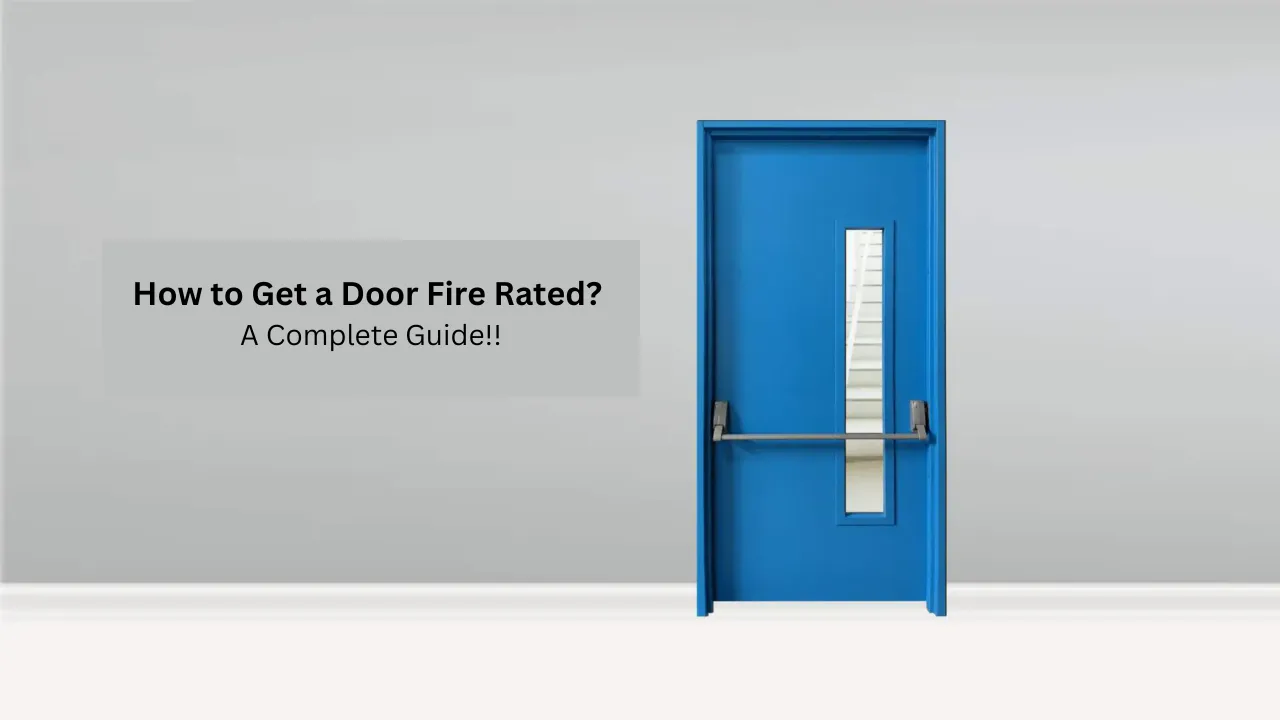Fire-rated doors can improve safety, especially for commercial and residential spaces. They are not just a regulatory requirement in some areas; they are an important safety feature. These doors prevent the spread of fire and protect lives and property by giving people more time to escape and allowing firefighters to control the flames.
In today’s guide, we’ll cover everything you need to know about getting a door fire-rated, from understanding what makes a fire-rated to certifying one.
What Is a Fire-Rated Door?
Depending on the rating, a fire-rated door is designed to withstand fire for a certain period, typically between 20 minutes and 3 hours. This extra time is a barrier, stopping the fire from spreading quickly. Fire-rated doors are especially important in areas such as commercial buildings, apartments, schools, and hospitals where safety compliance is critical.
Steps to Get a Door Fire Rated
1. Understand the Standards and Regulations
- The first step is to familiarize yourself with the international and local standards for fire safety. Some organizations, like the National Fire Protection Association (NFPA), have strict guidelines about materials, construction, and waiting for fire doors.
- These ratings are often presented by how long the door can withstand the exposure, and the common ratings are 20, 45, 60, 90, or 180 minutes. For more information, refer to NFPA 80: Standard for Fire Doors and Other Opening Protectives.
2. Check the Door Type and Material
- Checking the door material is also crucial, as only some doors can be fire-rated. These doors are constructed with solid wood, metal, gypsum, or glass (if treated to resist fire).
- If you have an existing door, you must verify whether it’s made from fire-resistant material. Sometimes, you may need to install a new door altogether.
3. Get Your Door Tested by a Certified Lab
- If you are still figuring out whether your door is fire-rated, you should have it tested by a certified lab. You can send it to a third-party testing lab approved by local building codes, like Underwriters Laboratories (UL) or Intertek.
- Testing labs simulate fire exposure on the door for the time specified by the rating.
4. Install Certified Fire-Resistant Components
- A door alone is insufficient to prevent the fire from spreading; you also need fire-resistant hinges, seals, frames, and locks.
- Fire-rated doors usually have intumescent seals that expand under heat and seal gaps of any type. This expansion helps to block smoke and flames passing by.
5. Labelling and Certification
- After the door passes the test, it will receive a fire rating label. This label has information such as the rating, the agency’s name, and the testing date.
- The building inspector then needs this label, and it should remain visible for easy reference during the inspections.
Fire-Rated Door vs. Non-Fire-Rated Door
| Feature | Fire-Rated Door | Non-Fire-Rated Door |
| Purpose | Prevents spread of fire and smoke | Standard functionality |
| Materials | Fire-resistant materials like metal or gypsum | Regular wood or metal |
| Seals | Have intumescent seals to block smoke | No special seals |
| Testing & Certification | Tested by certified labs, with visible labelling | No special testing |
| Common Ratings | 20, 45, 60, 90, 180 minutes | No fire-resistance rating |
Key Components of a Fire-Rated Door
- Fire-Resistant Material: Metal, solid wood, or treated glass.
- Intumescent Seals: Seals that expand in heat, blocking smoke.
- Self-Closing Mechanism: Prevents the door from accidentally staying open.
- Fire-Rated Frame: Ensures a complete barrier.
- Hinges and Locks: Must be tested for high temperatures.
Frequently Asked Questions (FAQs)
Not really! Not every door can be rated fire, as these doors need specific materials, constructions, and components designed to withstand fire.
It would be best to look for the certification level on the door edge or near the hinges.
Some glass doors can be fire-rated if treated and tested. Fire-rated glass doors are made from ceramic or wire mesh to prevent shattering during high heat.
Fire-rated doors in commercial spaces must be inspected annually to ensure they are fully functional.
BAC-PPA-RE Floor Access Door
If you are working in a space that requires a fire-rated flooring solution, you might consider installing BAC-PPA-RE floor access doors. They are designed to provide easy access to building infrastructure while keeping fire safety compliance. They are important for areas that need both accessibility and protection, and they are tested and certified.
In Summary
Getting a fire-rated door includes more than just buying the right door. It involves adhering to safety regulations, using certified materials, and ensuring your setup is functional and effective in an emergency. Prioritizing fire safety in all aspects of building design is always recommended, as it is a proactive measure to safeguard people and property.
Also Read:

